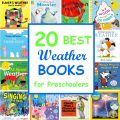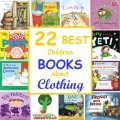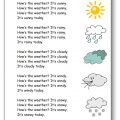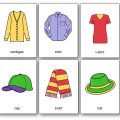Author: Harriet Ziefert
Illustrator: Arnold Lobel
Publisher: Harper & Row
Year: 1982
Language: English
Type of resource: Illustrated picture book
Themes: Clothing, weather, daily routines
Age range: 3 to 8 years old
School levels: Preschool, Kindergarten, Grade 1, Grade 2
Main learning objective: To introduce vocabulary related to clothes and weather in English through a repetitive and predictable narrative.
Main language objective: I can say what I wear when it’s sunny, rainy or snowy.
Summary of the Book
Every morning, Bear wakes up and chooses his clothes depending on the weather. Is it cold, warm, rainy or windy? On each page, children are invited to guess what Bear will wear using visual clues. The repetitive structure and rhythmic language support memory and comprehension. At the end of the day, Bear gets ready for bed, closing the daily routine cycle. A simple, interactive and engaging story — perfect for early English learners.
Culture and Vocabulary
This book emphasizes the importance of observing the weather and dressing accordingly — a valuable life skill that is especially encouraged in English-speaking cultures. Children are taught to make responsible choices from an early age, and choosing clothes based on the weather is often one of the first steps toward independence. This link between weather and autonomy offers a rich cultural and practical entry point for ESL learners.
Clothing vocabulary: sweater, slicker (raincoat), mittens, shorts, windbreaker, slippers, tank top, swim trunks, hat, boots
Weather vocabulary: chilly, rainy, snowy, sunny, windy
Colors: red, yellow, green, blue
Sensory adjectives: warm, dry, cozy, good
Times of day: morning, evening
Common verbs: begins, dress, see, guess
Key expressions: What will he wear?, See if you can guess
Idiomatic/rhyming expressions: silly chilly day, muddle puddle day, snowy blowy day, funny sunny day, sneezy breezy day. These alliterations and rhymes boost listening and phonological awareness.
Grammar and Structures
- Simple Present: “Bear gets dressed”. Introduces a key tense to describe daily routines — ideal for young learners.
- Future question with “will”: “What will he wear?”. Great for working on prediction and introducing future structures in a playful context.
- Imperative / invitation: “See if you can guess.” A simple command that encourages student interaction, guessing and engagement.
- Contracted forms: “It’s snowing outside!” Exposes learners to common contractions used in spoken English.
- Descriptive compound adjectives with rhyme: “snowy blowy day”, “muddle puddle day”. Encourages appreciation of language play and introduces musicality of English.
- Possessive structures: “My red sweater”. A simple and authentic use of possessives plus color adjectives.
Phonology
- Focus on sounds [s], [z] and [ʃ]: as in dress, guess, slicker, snowy, breezy
- Rhymes and rhythm support oral fluency: chilly/silly, muddle/puddle, snowy/blowy, sunny/funny, sneezy/breezy
- Alliteration: repetition of initial sounds like in muddle puddle, silly chilly helps develop phonemic awareness
- Prosody and intonation in questions and exclamations: “What will he wear? See if you can guess!”. Great for working on natural rhythm and classroom interaction patterns.
- Sound contrasts: hot vs cold, dry vs wet. Ideal for listening discrimination and vocabulary reinforcement
Teaching Suggestions
Before Reading
- Show the book cover and guess who the character is and what might happen
- Introduce clothing and weather words with flashcards or real clothing items
- Play a miming game: Put on your hat, Take off your sweater
During Reading
- Pause after each “What will he wear?” question and let students guess
- Act out sensory adjectives using gestures: warm, dry, cozy
After Reading
- Matching game: clothes and weather (sorting cards)
- Drawing activity: draw Bear according to today’s weather
- Grammar mini-lesson: build simple oral sentences with He is wearing…
Cross-Curricular Connections
Music: “How’s the Weather?”, “Put On Your Shoes” by Super Simple Songs
Civic and Social Education: Learning to dress appropriately, taking care of oneself
Visual Arts: Make a Bear wardrobe with Velcro clothing
Media Literacy: Sorting images from magazines or digital catalogs (paper or digital)
PE: Mime games to act out different kinds of weather (wind, sun, rain…)
Project Ideas
Group project – Bear’s Suitcase
Objective: Pack Bear’s suitcase for a trip to a hot, cold or rainy place. Children choose, cut, glue and label clothes Bear will need and justify their choices: He needs a scarf because it’s cold in Canada. This can be spread over several sessions and presented as a booklet or class display.
Book comparison and extension
Read Maisy’s Weather Book by Lucy Cousins or Froggy Gets Dressed by Jonathan London (Amazon Affiliate Links) to expand vocabulary and explore similar themes.
Conclusion
Bear Gets Dressed is an excellent resource to introduce and reinforce weather and clothing vocabulary for young ESL learners. Its repetitive and predictable structure, playful rhymes, and interactive format make it ideal for supporting oral comprehension, early grammar awareness, and confident speaking. This book easily adapts to different proficiency levels and allows for a range of classroom activities, from dramatization to cross-curricular projects. A must-have for any ESL classroom looking to link English learning with autonomy and fun!





